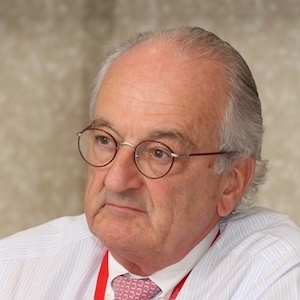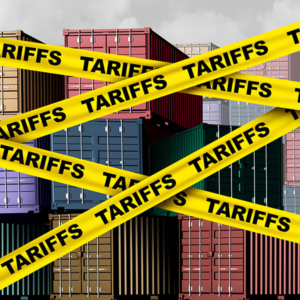
There’s been growing discussion, in both the trade and other media, about just what Kimberley Process (KP) certification stands for, particularly following Russia’s invasion of Ukraine.
Despite calls from the Ukraine’s KP rep and a handful of Western countries to label Russian diamonds as “conflict,” the certification scheme declined even to take up the matter at its June intersessional in Gaborone, Botswana. While substantive action on that topic was never expected, the KP’s generally static nature has led normally supportive governments to question its continued relevance.
At the Initiatives in Arts and Culture’s gold and diamond conference, held July 18–20 in New York City, I spoke with World Diamond Council (WDC) president Edward Asscher (pictured) about that and related issues. The WDC represents the industry in front of the KP.
Not everyone will agree with what Asscher—or I—say here. While Asscher is far less of a KP skeptic than I am, we both agreed that it only guarantees certain things, and concerned companies should look beyond its rather limited scope. And his mention of a possible “KP 2” was surprising.
You can watch our entire one-hour exchange here or at the end of this post, but below—greatly edited for length and clarity—are some key points.
I’ve heard talk recently that the KP is a “baseline.” How should we look at the Kimberley Process as far as what it guarantees and what it does?
For those who don’t know, the United Nations established the Kimberley Process in 2003. It has three pillars: governments, of which there are now 86; civil society; and the World Diamond Council, representing the whole diamond industry.
The KP is the basis of everything we do. The KP means that, to get exported, rough diamonds need a certificate from the legitimate government of the country. When they are imported, they need that certificate to be imported. Without the KP certificate, you cannot do business in the industry.
The KP’s definition of conflict diamonds is limited to diamonds in the hands of rebel movements that use the proceeds to overthrow a legitimate government. That’s a very limited definition, and that’s what all the discussion has been about for the last 15 years.
We want a wider definition [that includes human rights violations connected to diamonds], but the Kimberley Process is also based on consensus [among all the participating governments].
We had a review cycle a few years ago and we were [close to changing the definition] and one of the governments said, “maybe not.” We will start a new review cycle next year under [2023 chair] Zimbabwe, and we are now working on how to prepare to get the definition changed.
Given the inability to get the definition of conflict diamonds changed, do you think that it’s proper for companies to just rely on the Kimberley Process and say everything is fine?
It is not a perfect world. You can’t say everything is 100% good. But I will say that it is 99-point-something [percent] good, [as] a majority of all the diamonds in the world are “conflict-free,” according to the current definition…. If you look at the present supply chain of rough diamonds, I’m pretty sure there are very few conflict diamonds going around.
Yet, we have seen situations where diamonds from Zimbabwe, Tanzania, and Angola were all tied to violence and received KP certificates. I understand the KP has a specific definition of conflict diamonds, but most people would use that term interchangeably with blood diamonds, meaning diamonds associated with violence. Given that, can we really say KP diamonds are conflict-free?
You can’t generalize. You have to look at each individual country and each individual mine. In Tanzania with the Williamson mine, [mine owner] Petra [was] not very experienced in Tanzania. When people came into the fields to steal diamonds, they called in the government troops and the government troops were trigger happy and all kinds of things happened that should not have happened.… Petra paid millions of dollars to the people involved, and it stopped.
Can it happen again? Yes. And each time you have to deal with it.
You can’t say if there is something happening in Angola—which is a very big producer of diamonds—we should put sanctions on the whole country.
Years ago, when Angola wanted to become the chair of the KP, the situation at the alluvial mines in Angola was absolutely not acceptable. We told them that if you want to become the chair of the KP you first have to clean up your production. And only a few years later, they did and became chair of the KP.
With Zimbabwe [poised to be the next] chair, all three Zimbabwe NGOs told us at the recent intercessional that the situation in Zimbabwe has very much improved. That is something that we hoped would happen.
But still, given that the current definition is limited, and some of those diamonds involved in violence were exported with KP certificates, do you think that just relying on a KP certificate is enough?
I have to think about that. Both answers I can give are wrong. If I say yes, then it’s not 100% true, and if I say no, it is not 100% true.
A KP certificate is a guarantee that the diamonds have been officially exported by the government according to the rules and standards of the KP. If, at a certain mine or a certain stream, there are violations of human rights and we hear about them or they are brought to our attention, we act on them.
Let’s talk about Russia. I agree that the KP shouldn’t address extraneous issues. But given that Alrosa—which is Russia’s primary diamond producer—is one-third owned by the Russian government, do you consider Alrosa’s diamonds “conflict”?
We know the definition of conflict diamonds. Russian diamonds do not fulfill that definition. Whether you like it or not, that’s the truth.
If you introduce a political argument into the [Kimberley Process], that is not correct. Am I defending Russia? No, not at all. I’m not defending the war. I’m just talking about the diamond issue, I don’t see [the war’s] connection [to diamonds]. But if you want to make it, then, of course [you can].
But it’s the first time in 19 years that one Kimberley Process member has attacked another. That’s disturbing, correct?
Yes. You’re right. I think that the discussion at the KP as it started in Botswana was valuable and correct, because you can’t close your eyes.
There was a big fight and then the chair suspended the whole procedure. It took three hours to talk to the various participants and then it was decided that we should continue with the agenda…because there is technical work that has to be done on the KP to let the KP function correctly. I respect the discussion, but there is no place to kick out Russia [because the KP] requires consensus.
Let me talk a little bit about consensus. Without consensus, the United Nations would never have been able to form the Kimberley Process. The only reason why it was done was because of consensus.
But given how difficult it is to reach consensus, a lot of organizations have left the KP, because they say it never makes progress. Does the industry need to start thinking about a different kind of approach rather than relying on this very bureaucratic model?
The answer to that is yes. I think that people who want to destroy the KP are totally irresponsible. But we have to think about: Is there a Kimberley Process 2 in the future? The answer to that is also yes.
I read an article The Economist last week about cobalt. When I read what is happening [with the mining of the mineral], with the abuse of kids and child labor, and I compare that to what had we have achieved so far, we are way ahead of other industries.
Is the KP perfect? No, absolutely not. Should we think creatively and out of the box about a KP 2? I’ve talked about that with many experts, and we have not yet come up with a proposal or solution. But I think what we have is not good enough and we need more.
I’ve known you for years, and I know that you care about these issues. But it’s an unfortunate fact that not everybody in the industry does, or we wouldn’t have these problems. So how does the industry get better at self-policing and making sure that everybody understands that this is a new world and the industry has to live up to the highest standard?
You might ask the same thing about journalists. That is something I often ask myself.
When I first became president of the World Diamond Council in 2014, I was talking about accountability and transparency. That didn’t make me very popular. Now, eight years later, there’s no need to talk about that because there’s nobody in the diamond world who doesn’t show accountability and transparency.
Sometimes it takes a long time, but you can have an influence. And that is what we try. And sometimes we fail, but there are those rare moments of success.
Photo by Donald Woodrow (courtesy of World Diamond Council)
- Subscribe to the JCK News Daily
- Subscribe to the JCK Special Report
- Follow JCK on Instagram: @jckmagazine
- Follow JCK on X: @jckmagazine
- Follow JCK on Facebook: @jckmagazine





